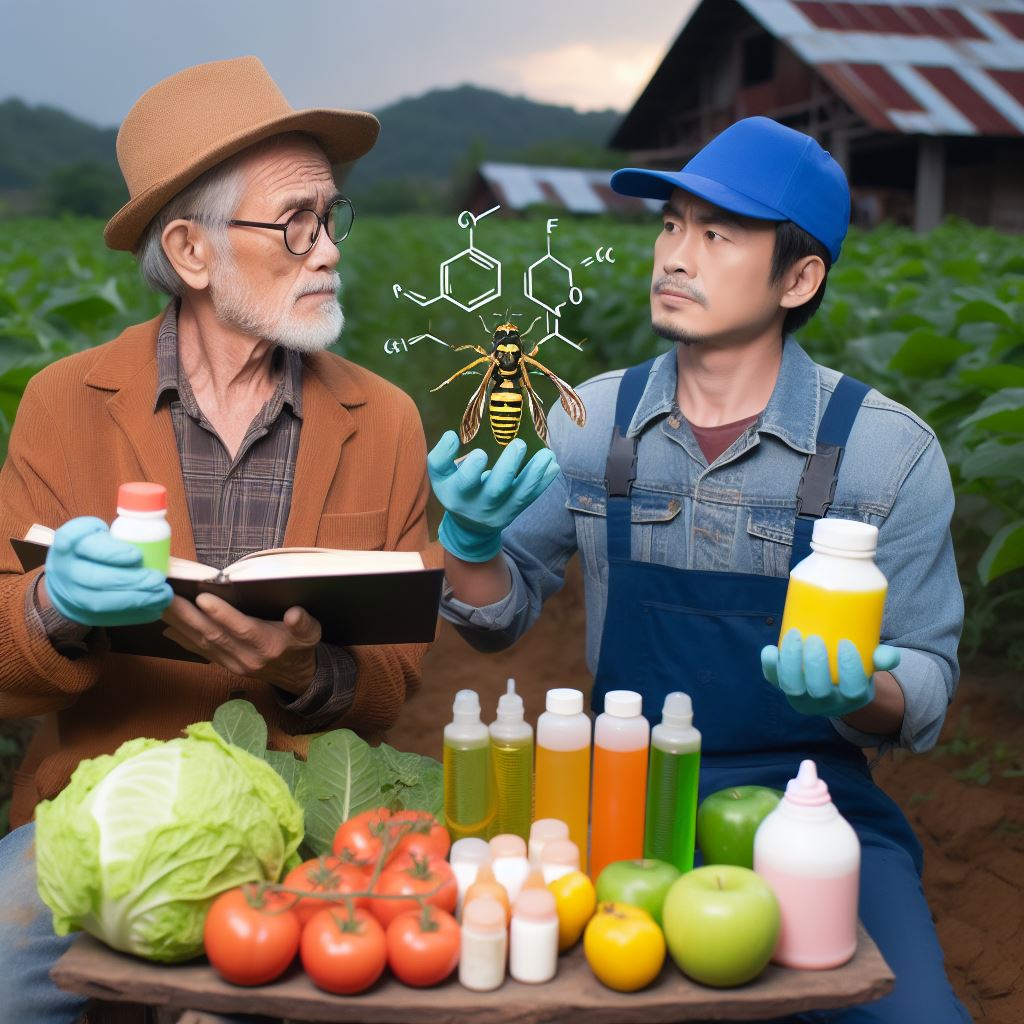Chemical Pesticides: Pros and Cons Explained
Last Updated on March 2, 2024
Introduction
Chemical pesticides play a crucial role in modern agriculture, ensuring high crop yields and food security.
They help farmers combat destructive pests efficiently, ensuring food security and reducing economic losses due to crop damage.
Additionally, pesticides enable farmers to produce higher yields on limited land, contributing to meeting the growing global food demand.
However, their indiscriminate use raises concerns about environmental pollution, health risks, and the development of pesticide-resistant pests.
Proper regulation, integrated pest management strategies, and innovation in safer pesticide alternatives are essential for sustainable agricultural practices.
Chemical pesticides have both advantages, such as increased productivity, and disadvantages, such as environmental and health risks.
Chemical pesticides offer quick and effective control over pests, enhancing crop yields and safeguarding public health by reducing diseases transmitted by insects.
They’re relatively easy to apply and cost-effective, aiding in mass agricultural production.
However, their indiscriminate use can lead to environmental pollution, harm non-target organisms, and contribute to the development of pesticide-resistant pests.
Residue accumulation in food raises health concerns, while some pesticides persist in the environment, affecting ecosystems.
Additionally, their toxicity poses risks to farmworkers and consumers. Balancing their benefits with environmental and health impacts is crucial for sustainable agriculture.
The purpose of this blog post is to provide a comprehensive exploration of the pros and cons of chemical pesticides.
Pros of Chemical Pesticides
Chemical pesticides have been a valuable tool in agriculture for many years. Farmers rely on these substances to protect their crops from pests and increase their overall yields.
While there are concerns about the environmental and health impacts of chemical pesticides, it is important to explore their positive aspects as well.
Effectiveness in controlling pests
One of the main advantages of chemical pesticides is their effectiveness in controlling pests.
These substances have been extensively tested and formulated to target specific pests, ensuring maximum impact.
When applied correctly, chemical pesticides can eliminate pests and prevent crop damage effectively.
Increased crop yields and protection from damage
In addition to controlling pests, chemical pesticides contribute to increased crop yields and protection from damage.
Pests can destroy entire crops, leading to financial losses for farmers. By using chemical pesticides, farmers can safeguard their crops and produce higher yields, maximizing their profits and ensuring food security.
Reduction of disease transmission
Another essential benefit of chemical pesticides is the reduction of disease transmission. Many pests carry harmful diseases that can spread to humans and animals.
Chemical pesticides help eliminate these disease carriers, reducing the risk of outbreaks and protecting public health.
Cost-effectiveness for farmers
From a financial perspective, chemical pesticides are cost-effective for farmers.
Investing in these substances and applying them adequately can prevent crop failure and the associated financial losses.
Chemical pesticides act as insurance for farmers, ensuring stable incomes and economic sustainability.
Availability and ease of use
Furthermore, chemical pesticides are readily available and easy to use. Farmers can access these products through various suppliers, making them accessible to small-scale farmers as well.
Additionally, the ease of use allows farmers to apply the pesticides without extensive training, reducing complications and maximizing efficiency.
Despite these benefits, it is important to address the potential downsides and strive for a balanced approach.
The environmental impact of chemical pesticides and their potential health risks cannot be ignored.
However, recognizing the pros of chemical pesticides is essential for understanding their significance and role in modern agriculture.
In general, chemical pesticides offer several advantages in the field of agriculture.
They are highly effective in controlling pests, increase crop yields, reduce disease transmission, and prove cost-effective for farmers.
Additionally, their availability and ease of use make them accessible to farmers of all scales.
However, it is crucial to consider their potential negative effects and work towards sustainable and environmentally friendly alternatives.
Read: No-Till Farming: Pros & Cons
Cons of Chemical Pesticides
Adverse effects on human health
Chemical pesticides have been linked to various health issues, including cancer, respiratory problems, and neurological disorders.
Chemical pesticides pose numerous cons, notably adverse effects on human health. Exposure to these toxins through ingestion, inhalation, or skin contact can lead to acute and chronic health issues, including respiratory problems, neurological disorders, and cancer.
Prolonged use contributes to the development of pesticide resistance in pests, necessitating stronger chemicals. Furthermore, pesticide residues can persist in food, water, and soil, contaminating ecosystems and endangering non-target organisms.
Additionally, indiscriminate application can disrupt natural ecosystems and harm beneficial insects vital for pollination and pest control. These factors collectively highlight the significant health and environmental risks associated with chemical pesticides.
Harm to non-target organisms and ecosystems
These pesticides not only kill pests but also have detrimental effects on beneficial insects, birds, and aquatic organisms.
Chemical pesticides pose significant risks to non-target organisms and ecosystems. These substances can harm beneficial insects like bees, essential for pollination, and predators that control pest populations naturally.
Moreover, pesticides can contaminate soil and water, affecting plant growth and aquatic life. They may also disrupt the balance of ecosystems by killing off species integral to the food chain, leading to imbalances and potential collapses in biodiversity.
Furthermore, prolonged use of chemical pesticides can contribute to the development of pesticide-resistant pests, exacerbating the need for stronger chemicals and perpetuating a harmful cycle.
Development of pesticide resistance in pests
Over time, pests can become resistant to the chemicals used, making it harder to control their populations effectively.
Chemical pesticides contribute to the development of pesticide resistance in pests due to their repeated use. As pests are exposed to these chemicals over time, they can adapt and develop genetic mutations that make them immune to the pesticide’s effects.
This leads to the need for higher doses or more potent pesticides, escalating environmental and health risks. Additionally, pesticide resistance reduces the effectiveness of pest control measures, diminishing crop yields and increasing economic losses for farmers.
Furthermore, the proliferation of resistant pests can disrupt ecosystems and harm beneficial organisms, exacerbating ecological imbalances.
Environmental pollution and disruption
Chemical pesticides often contaminate soil, water, and air, causing harm to biodiversity, disrupting ecosystems, and reducing overall environmental quality.
Chemical pesticides pose significant environmental cons due to pollution and disruption. Their widespread use contaminates soil, water, and air, harming non-target organisms like beneficial insects, birds, and aquatic life.
Pesticides can leach into groundwater, affecting drinking water quality and leading to bioaccumulation in food chains. They contribute to biodiversity loss by disrupting ecosystems and harming pollinators crucial for agriculture.
Furthermore, pesticide residues persist in the environment, causing long-term harm to both terrestrial and aquatic habitats.
Overall, the environmental impact of chemical pesticides underscores the urgency for sustainable pest management alternatives to mitigate pollution and ecological disruption.
Risk of chemical residues in food
Consumption of pesticide-laden food can pose significant risks to human health, especially when ingesting large amounts over time.
Chemical pesticides pose numerous cons, including the risk of chemical residues in food. These residues can accumulate in crops, potentially leading to health hazards when consumed.
Prolonged exposure to pesticide residues has been linked to various health issues, such as cancer, hormonal disruption, and neurological disorders. Additionally, chemical pesticides can harm non-target organisms, including beneficial insects, birds, and aquatic life, disrupting ecosystems and biodiversity.
Moreover, the overuse of chemical pesticides contributes to environmental pollution, contaminating soil, water sources, and air. These drawbacks highlight the urgent need for safer and more sustainable pest management practices.
It is crucial to consider these cons when evaluating the use of chemical pesticides. While they may provide short-term benefits in pest control, the long-term ramifications on human health and the environment cannot be ignored.
As such, alternative methods like organic farming and integrated pest management should be explored and encouraged.
Read: Crop Diversity Benefits Revealed

Find Out More: Climate-Smart Farming: Adapting to Drought
Impact on Agricultural Sustainability
Debate on sustainability and chemical pesticide use
Chemical pesticide use has sparked a debate on its impact on agricultural sustainability.The debate on agricultural sustainability and chemical pesticide use centers on its multifaceted impacts.
Advocates argue that pesticides ensure crop productivity, safeguarding against pests and diseases, vital for global food security.
Conversely, critics highlight concerns over pesticide residues, soil degradation, and harm to non-target organisms, threatening biodiversity and ecosystem health.
Transitioning to integrated pest management (IPM) and organic practices offers alternatives, promoting ecological balance and reducing chemical dependency.
Balancing yield demands with environmental and health considerations is paramount for agricultural sustainability, necessitating policy interventions, technological innovation, and farmer education to foster a more holistic approach to pest management.
Alternative choices for pesticide application
Farmers are exploring alternative choices for pesticide application to minimize environmental damage.
Alternative choices for pesticide application, such as integrated pest management (IPM), organic farming, and biotechnology, significantly impact agricultural sustainability.
IPM promotes natural predators, crop rotation, and resistant plant varieties to control pests, reducing reliance on chemical pesticides. Organic farming avoids synthetic pesticides altogether, preserving soil health and biodiversity.
Biotechnology offers genetically modified crops resistant to pests, reducing pesticide usage. These alternatives mitigate environmental degradation, protect pollinators, and ensure long-term agricultural viability.
Embracing diverse methods not only safeguards ecosystems but also promotes resilient farming practices, vital for sustainable food production in the face of climate change and resource constraints.
Integrated Pest Management (IPM) approaches
Adopting Integrated Pest Management (IPM) approaches can effectively reduce the use of chemical pesticides.
Integrated Pest Management (IPM) revolutionizes agricultural sustainability by minimizing chemical inputs while maximizing crop yields. Through a multifaceted approach, IPM combines biological, cultural, and chemical control methods to manage pests effectively.
This strategy reduces pesticide use, curbing environmental pollution and preserving biodiversity. Farmers adopting IPM experience improved soil health, enhanced water quality, and reduced health risks for humans and wildlife.
Additionally, by fostering natural predator-prey relationships and crop rotation, IPM mitigates pest resistance, ensuring long-term crop protection. Ultimately, IPM promotes resilient agricultural systems, fostering sustainability by balancing economic viability with environmental stewardship.
Adoption of organic farming practices
The adoption of organic farming practices is gaining traction as a sustainable alternative to chemical pesticides.
Theses practices significantly impacts agricultural sustainability by promoting soil health, biodiversity, and reduced environmental pollution.
Organic methods eschew synthetic fertilizers and pesticides, relying instead on natural inputs like compost and crop rotation, which enhance soil fertility and structure. This approach mitigates soil erosion and degradation, preserving farmland for future generations.
Moreover, organic farming encourages biodiversity, supporting diverse ecosystems and pollinators crucial for crop health.
By reducing reliance on chemical inputs, organic agriculture minimizes water pollution and greenhouse gas emissions, contributing to a more sustainable and resilient agricultural system in the face of climate change.
Read: Best Times to Harvest Corn: Key Tips & Tricks
Regulation and Safety Measures
Government regulations and pesticide registration
- Government regulations play a crucial role in ensuring the safety and effectiveness of chemical pesticides.
- Pesticides need to undergo extensive testing and evaluation before receiving registration from regulatory authorities.
- Registration ensures that only approved pesticides are available in the market for use.
- Regulatory agencies carefully review the composition, toxicity, and potential environmental impacts of pesticides.
Importance of label instructions and safety guidelines
- Pesticide labels contain essential information for the safe and proper use of the product.
- Label instructions provide guidelines regarding application rates, timing, and precautions to protect human health and the environment.
- Following label instructions is crucial to minimize risks associated with pesticide use.
- Proper storage, handling, and disposal of pesticides are also emphasized in safety guidelines.
Strict monitoring, testing, and enforcement
- Regulatory agencies have a responsibility to monitor and enforce compliance with pesticide regulations.
- Random testing of pesticide residues in crops and products helps ensure adherence to safety standards.
- Enforcement actions, including penalties and fines, are imposed on violators to deter misuse and promote accountability.
- Regular inspections of pesticide application practices on farms contribute to improved safety.
Development of less toxic or bio-based alternatives
- In response to concerns about chemical pesticides, efforts have been made to develop safer alternatives.
- Research focuses on the development of less toxic pesticides with reduced environmental impact.
- Bio-based alternatives, such as biological control agents, biopesticides, and integrated pest management strategies, are gaining attention.
- These alternatives offer effective pest control while minimizing the risks associated with chemical pesticides.
Education and training for farmers
- Providing education and training to farmers is crucial for promoting safe pesticide use.
- Farmers need to be aware of proper application techniques, protective measures, and potential risks.
- Training programs can enhance farmers’ understanding of integrated pest management practices and sustainable agriculture
- By empowering farmers with knowledge, the safe and responsible use of pesticides can be promoted.
Read: Sustainable Water Use in Farms
Explore Further: Reducing Farming’s Carbon Footprint
You Might Also Like: Drought-Tolerant Crops: A Guide for Farmers
Conclusion
This blog post has discussed the pros and cons of chemical pesticides. The pros include their effectiveness in controlling pests and increasing crop yields.
However, the cons include their negative impact on the environment, human health, and wildlife. Therefore, it is important to take a balanced approach to pest management.
This means taking into consideration alternative methods such as biological control and integrated pest management. It is also crucial to prioritize ongoing research and innovation in the field of pest management.
This will help develop safer and more sustainable alternatives to chemical pesticides. By constantly improving and investing in these alternatives, we can minimize the negative effects of chemical pesticides while still protecting our crops.
Ultimately, the goal should be to find a balance between pest control and environmental preservation. With continued research and innovation, we can achieve this goal and ensure a healthier and more sustainable future.


